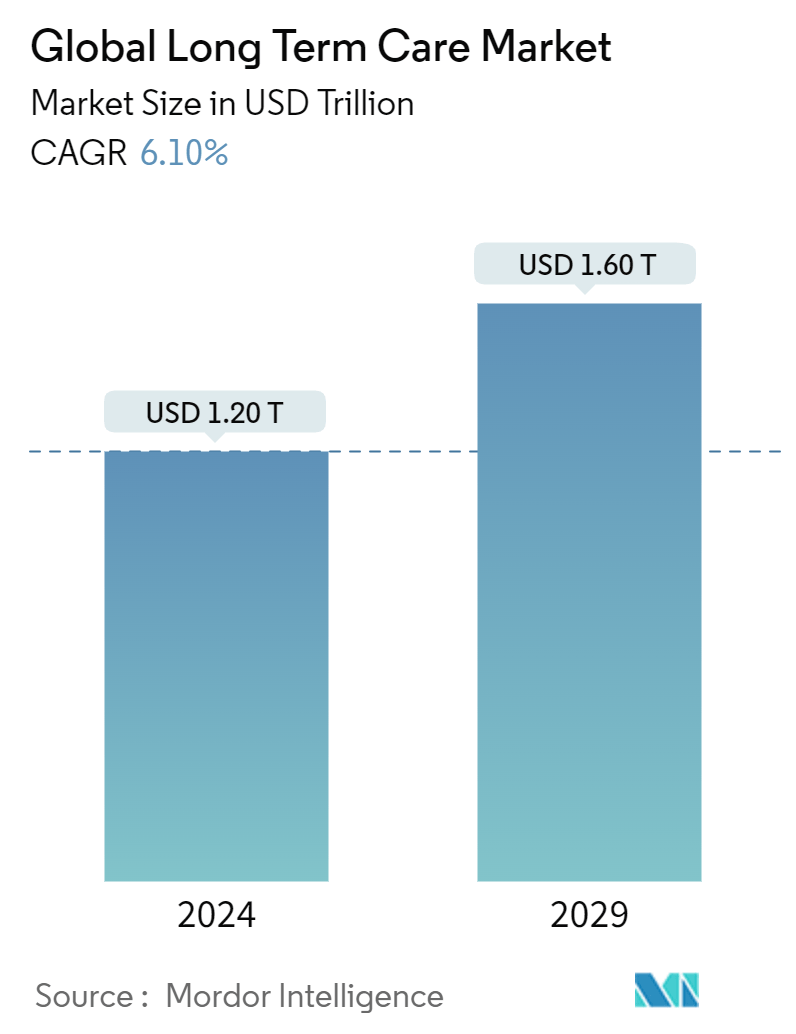Market Size of Global Long Term Care Industry

| Study Period | 2019 - 2029 |
| Market Size (2024) | USD 1.20 Trillion |
| Market Size (2029) | USD 1.60 Trillion |
| CAGR (2024 - 2029) | 6.10 % |
| Fastest Growing Market | Asia-Pacific |
| Largest Market | North America |
Major Players
*Disclaimer: Major Players sorted in no particular order |
Long Term Care Market Analysis
The Global Long Term Care Market size is estimated at USD 1.20 trillion in 2024, and is expected to reach USD 1.60 trillion by 2029, at a CAGR of 6.10% during the forecast period (2024-2029).
Megatrends Shaping the Industry: The Global Long Term Care Market is undergoing substantial growth, driven by powerful megatrends such as the aging global population, evolving family dynamics, and escalating healthcare costs. These trends are setting the stage for expanded long-term care services, bolstered by rising demand, improved insurance offerings, and technological advancements in healthcare delivery. These drivers are facilitating broader access to long-term care facilities and creating sustainable growth opportunities within the industry.
Favorable Long Term Care Insurance Plans: Insurance plans tailored to long-term care are playing a critical role in expanding market accessibility. The introduction of flexible and comprehensive long-term care insurance (LTCI) products is gaining traction, especially in Europe, where countries such as Germany and the Netherlands have integrated long-term care coverage into their social welfare systems. Germany's Pflegeversicherung covers various long-term care services, including home care and nursing homes. In the Netherlands, the Long-Term Care Act extends coverage to both residential and community-based care, helping to alleviate financial burdens. These insurance mechanisms are key to making long-term care more affordable and accessible, significantly driving the market forward.
Increasing Adoption of Long Term Care Services Among Old Population Base: As the global geriatric population grows, the demand for long-term care services is rising. Increasing awareness, changing family structures, and a desire for independence are prompting more seniors to seek professional care services. Countries like South Korea are leading the way by implementing universal long-term care insurance to support their elderly population. Furthermore, the European Care Strategy is driving long-term care policy reform across the European Union, making care services more accessible and improving working conditions for care providers. This growing adoption is essential to sustaining the long-term care industry's expansion.
Technological Advancements in the Field of Long-Term Care: Technology is revolutionizing the long-term care sector, optimizing both the quality of care and operational efficiency. Innovations like Electronic Health Record (EHR) systems, telehealth, remote patient monitoring, and electronic medication management systems are enhancing care coordination and enabling real-time patient health tracking. Assistive technologies, such as wearable devices, smart home automation, and fall detection systems, are improving safety and independence for individuals with age-related conditions. These advancements are transforming the sector, making care services more effective and appealing, while contributing to the industry's growth.
Long Term Care Industry Segmentation
As per the scope of the report, long-term care involves a range of care levels or settings, such as adult daycare, nursing homes, hospices, and home health care. The main role of long-term care is to help patients maintain a maximum degree of functional independence while providing continuous care, from low-intensity services to post-acute care.
The long-term care market is segmented by service and geography. By service, the market is segmented into home healthcare, hospice, nursing care, assisted living facilities, and others. By geography, the market is segmented into North America, Europe, Asia-Pacific, Middle East, and Africa, and South America. The market report also covers the estimated market sizes and trends for 17 different countries across major regions globally. The report offers the value (in USD) for the above segments
| By Service | |
| Home Healthcare | |
| Hospice | |
| Nursing Care | |
| Assisted Living Facilities | |
| Others |
| Geography | ||||||||
| ||||||||
| ||||||||
| ||||||||
| ||||||||
|
Global Long Term Care Market Size Summary
The long-term care market is poised for significant growth, driven by various factors including the increasing adoption of long-term care homes by the aging population and advancements in technology. The COVID-19 pandemic initially disrupted the sector, particularly affecting nursing homes due to high resident-to-healthcare personnel ratios and the enclosed environment. However, the sector has shown resilience, with services resuming under strict guidelines and new care options emerging. Governments have adapted regulations and provided financial support to accommodate the needs of the elderly, while home-and-community-based care is gaining prominence. Technological innovations, such as the integration of electronic health records, are expected to enhance care delivery and outcomes, further propelling market expansion.
North America dominates the long-term care market, supported by a growing geriatric population, favorable government policies, and comprehensive insurance coverage. The region's market growth is bolstered by initiatives aimed at transforming health and social care systems to better serve older adults. Company developments and joint ventures, such as those by Extendicare, are also contributing to market growth. The market is characterized by a fragmented landscape with numerous regional and international players, including Brookdale Senior Living and Sunrise Senior Living. Strategic mergers and acquisitions, like Diversicare's agreement with DAC Acquisition LLC, are expected to strengthen market positions and drive further expansion.
Global Long Term Care Market Size - Table of Contents
-
1. MARKET DYNAMICS
-
1.1 Market Overview
-
1.2 Market Drivers
-
1.2.1 Favorable Long Term Care Insurance Plans
-
1.2.2 Increasing Adoption Of Long Term Care Services Among Old Population Base
-
1.2.3 Technological Advancements In The Field Of Long-Term Care
-
-
1.3 Market Restraints
-
1.3.1 Lack Of Awareness Regarding Long Term Care Services In Developing Regions
-
1.3.2 High-Cost Associated With The Services
-
-
1.4 Porter's Five Force Analysis
-
1.4.1 Threat of New Entrants
-
1.4.2 Bargaining Power of Buyers/Consumers
-
1.4.3 Bargaining Power of Suppliers
-
1.4.4 Threat of Substitute Products
-
1.4.5 Intensity of Competitive Rivalry
-
-
-
2. MARKET SEGMENTATION (Market Size by Value - USD)
-
2.1 By Service
-
2.1.1 Home Healthcare
-
2.1.2 Hospice
-
2.1.3 Nursing Care
-
2.1.4 Assisted Living Facilities
-
2.1.5 Others
-
-
2.2 Geography
-
2.2.1 North America
-
2.2.1.1 United States
-
2.2.1.2 Canada
-
2.2.1.3 Mexico
-
-
2.2.2 Europe
-
2.2.2.1 Germany
-
2.2.2.2 United Kingdom
-
2.2.2.3 France
-
2.2.2.4 Italy
-
2.2.2.5 Spain
-
2.2.2.6 Rest of Europe
-
-
2.2.3 Asia-Pacific
-
2.2.3.1 China
-
2.2.3.2 Japan
-
2.2.3.3 India
-
2.2.3.4 Australia
-
2.2.3.5 South Korea
-
2.2.3.6 Rest of Asia-Pacific
-
-
2.2.4 Middle East and Africa
-
2.2.4.1 GCC
-
2.2.4.2 South Africa
-
2.2.4.3 Rest of Middle East and Africa
-
-
2.2.5 South America
-
2.2.5.1 Brazil
-
2.2.5.2 Argentina
-
2.2.5.3 Rest of South America
-
-
-
Global Long Term Care Market Size FAQs
How big is the Global Long Term Care Market?
The Global Long Term Care Market size is expected to reach USD 1.20 trillion in 2024 and grow at a CAGR of 6.10% to reach USD 1.60 trillion by 2029.
What is the current Global Long Term Care Market size?
In 2024, the Global Long Term Care Market size is expected to reach USD 1.20 trillion.

